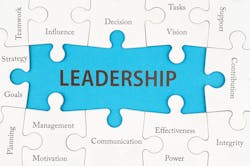Seeing Your Way to Becoming a Transformational Safety Leader
Doug Pontsler will be speaking at the Safety Leadership Conference 2021. He will present with Matthew Towner, safety, health and environment manager at Nestle, on "Filling in the Blanks: A New Toolset to Help Spot the Hazards We Could Be Missing." Click here for more details or to register for SLC 2021.
When we think of leadership, there are many characteristics that come to mind. These include qualities such as integrity, self-awareness, communication, caring and empathy.
Leaders have the power to make decisions and allocate resources to achieve business objectives. Ultimately, leaders determine the culture of the organization and establish the norms by which behaviors are understood to be acceptable or unacceptable within the organization.
However, leadership isn’t always that complicated. Safety leadership can be as simple as the Department of Homeland Security’s slogan: “If you see something, say something.”
"Today, leadership is essential at every level of an organization. It cannot be the exclusive domain of the top floor or the corner office."
Think about it. You’re walking through the plant and see an oil leak from a machine starting to enter the walkway. Or you see a co-worker not wearing the required safety eye protection. Or maybe you’ve just witnessed a near-miss incident—a pedestrian almost clipped by a forklift whose operator was wearing headphones and listening to music. Or in today’s COVID-19 environment, you see workers not maintaining appropriate social distancing or following sanitization protocols.
Your decision to say something about the hazard, near-miss incident or illness precursor is an act of leadership. A leader can be staff or line. The focus should not be on your title but rather on your ability to influence others in your organization. By alerting others to a hazard and speaking up, you’re a leader.
What it means to be a leader
Think of the leadership attributes that go into the slogan “If you see something, say something.”
- You are demonstrating situational awareness. You observed an abnormal situation, or a deviation, and became immediately aware of the danger, or the risk. You are paying attention to the environment around you.
- You are being self-reflective. You’re asking questions about yourself: How can I be most effective in sharing what I am seeing? How can I engage the team for solutions to what I see? How can I set an example that others will follow in their own behaviors?
- You’re being thoughtful and supportive. You’re showing that you genuinely care. By seeing a hazard and alerting others to it, you are supporting their safety.
- You’re being fair. You are not placing blame or making judgments. You know no one is perfect. We’re all human, and sometimes we forget to follow a safety precaution or assume someone else will take action.
- You’re slowing down. You’re taking the time to let others know about a hazard you’ve identified. Time is a precious commodity at all levels of an organization. Supervisors and frontline operators are pressed to get products out the door and to customers, but by taking the time to report safety hazards, you’re showing that safety is more important than quotas and deadlines.
- You’re taking initiative. You’re taking action when you could simply remain silent and let the moment pass. Leaders are action oriented, not passive onlookers.
- You’re communicating by speaking up with clarity, accuracy and precision. Effective leaders make good use of critical thinking skills to describe what you see and make informed decisions.
Why leaders need to be visually literate
The concept of “If you see something, say something,” is enhanced through visually literacy. Being visually literate moves leaders from just looking to really seeing what is happening.
You are able to recognize small details, defects, deviations and dangers that can be easily overlooked. That allows you to analyze and interpret the meaning of what you see. For example, the oil leak can result in a slip and fall—or worse. Not wearing eye protection can lead to vision damage or even blindness. The forklift operator can become situationally unaware and injure a pedestrian or damage plant property.
As leaders become more visually literate, they see in greater detail and draw more meaningful interpretations. The final step in visual literacy training is to determine what you are going to do about what you have seen.
Today, leadership is essential at every level of an organization. It cannot be the exclusive domain of the top floor or the corner office. Successful, sustainable and safe organizations have actively engaged employees in every department, on every floor and at every shift.
Engaged employees put their leadership responsibility first. They see, describe and analyze a hazard that needs to be fixed or a condition that needs to be controlled. They listen, ask questions and interact with nearby workers. As all good leaders intuit, engaged employees know they don’t have all the answers. The most effective way to solve problems is not through a solo effort.
Leaders don’t rush to judgment or conclusions. They take the time to describe what they see, analyze and interpret its meaning—what is the probability and severity of a risk, for example—and then communicate what they have learned or assessed so mitigating actions can be taken.
Leaders accomplish this through self-reflection. They know through visual literacy training that their observations (What do you see?) and assessments (What does it mean?) are subject to various personal biases that act as blinders or filters, distorting the reality of what they have encountered.
They learn to see their biases or prejudices for what they are and then put them aside. Leaders of all stripes and rank are fair, thoughtful and sensitive to their own fallibility. The most effective leaders check their egos at the door or, better yet, leave them at home. Ego, arrogance and hubris all interfere with the ability to see clearly and assess objectively.
What it means to be a visually literate leader
Communication is integral to the visual literacy methodology. Your time, observations, reasoning and evaluation of a hazard (physical, mechanical, behavioral, systemic or procedural) is for naught if you do not share what you’ve learned. After all, problems, dangers, defects or deviations cannot be corrected if you keep the information to yourself.
You don’t lead by operating in a vacuum or a silo. At any level of an organization, you lead by acquiring information—through observations, audits, hazard hunts, one-on-one safety contact conversations, behavior-based checklists and much more— and disseminating what you learn. What follows is collaboration; teamwork; and planning, prioritizing and problem-solving as needed.
Leadership is a set of traits. It is not a position. It’s not where you are placed on the org chart. Anyone can possess leadership characteristics and use them to protect themselves, their co-workers and the workplace. Leadership can be as simple as speaking up.
Doug Pontsler is chairman and managing director of COVE: Center of Visual Expertise. He was previously vice president of operations sustainability and EHS for Owens Corning. He served as a member of the National Safety Council (NSC)’s board of directors and as chairman of the NSC’s Campbell Institute. He is a recipient of NSC’s 2019 Distinguished Service to Safety Award.
About the Author

Doug Pontsler
Doug Pontsler is chairman and managing director of COVE, the Center of Visual Expertise. He was previously vice president of operations sustainability and EHS for Owens Corning. He served as a member of the National Safety Council (NSC)’s board of directors and as chairman of the NSC’s Campbell Institute. He is a past recipient of NSC’s Distinguished Service to Safety Award.
